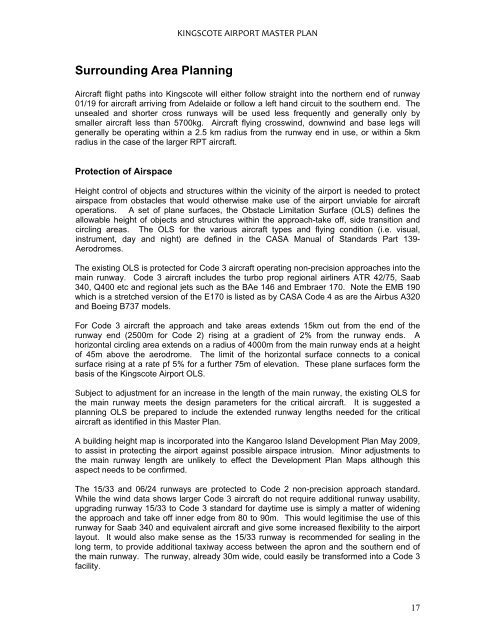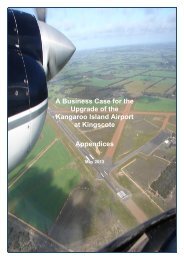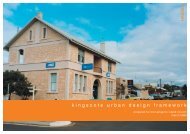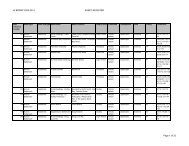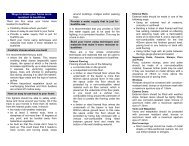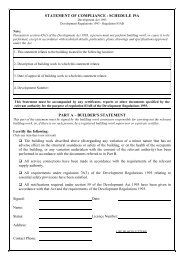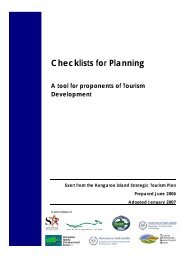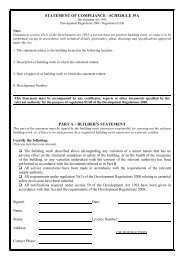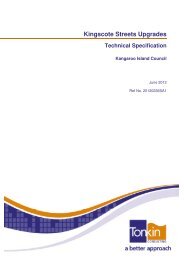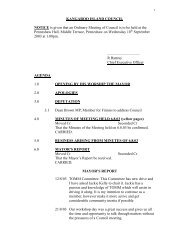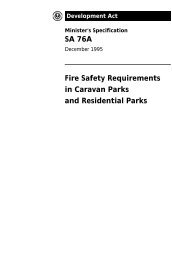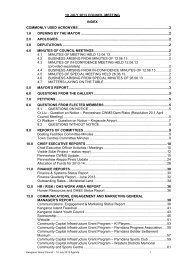Kingscote Airport Master Plan Apr 2010 - Kangaroo Island Council
Kingscote Airport Master Plan Apr 2010 - Kangaroo Island Council
Kingscote Airport Master Plan Apr 2010 - Kangaroo Island Council
You also want an ePaper? Increase the reach of your titles
YUMPU automatically turns print PDFs into web optimized ePapers that Google loves.
KINGSCOTE AIRPORT MASTER PLAN<br />
Surrounding Area <strong>Plan</strong>ning<br />
Aircraft flight paths into <strong>Kingscote</strong> will either follow straight into the northern end of runway<br />
01/19 for aircraft arriving from Adelaide or follow a left hand circuit to the southern end. The<br />
unsealed and shorter cross runways will be used less frequently and generally only by<br />
smaller aircraft less than 5700kg. Aircraft flying crosswind, downwind and base legs will<br />
generally be operating within a 2.5 km radius from the runway end in use, or within a 5km<br />
radius in the case of the larger RPT aircraft.<br />
Protection of Airspace<br />
Height control of objects and structures within the vicinity of the airport is needed to protect<br />
airspace from obstacles that would otherwise make use of the airport unviable for aircraft<br />
operations. A set of plane surfaces, the Obstacle Limitation Surface (OLS) defines the<br />
allowable height of objects and structures within the approach-take off, side transition and<br />
circling areas. The OLS for the various aircraft types and flying condition (i.e. visual,<br />
instrument, day and night) are defined in the CASA Manual of Standards Part 139-<br />
Aerodromes.<br />
The existing OLS is protected for Code 3 aircraft operating non-precision approaches into the<br />
main runway. Code 3 aircraft includes the turbo prop regional airliners ATR 42/75, Saab<br />
340, Q400 etc and regional jets such as the BAe 146 and Embraer 170. Note the EMB 190<br />
which is a stretched version of the E170 is listed as by CASA Code 4 as are the Airbus A320<br />
and Boeing B737 models.<br />
For Code 3 aircraft the approach and take areas extends 15km out from the end of the<br />
runway end (2500m for Code 2) rising at a gradient of 2% from the runway ends. A<br />
horizontal circling area extends on a radius of 4000m from the main runway ends at a height<br />
of 45m above the aerodrome. The limit of the horizontal surface connects to a conical<br />
surface rising at a rate pf 5% for a further 75m of elevation. These plane surfaces form the<br />
basis of the <strong>Kingscote</strong> <strong>Airport</strong> OLS.<br />
Subject to adjustment for an increase in the length of the main runway, the existing OLS for<br />
the main runway meets the design parameters for the critical aircraft. It is suggested a<br />
planning OLS be prepared to include the extended runway lengths needed for the critical<br />
aircraft as identified in this <strong>Master</strong> <strong>Plan</strong>.<br />
A building height map is incorporated into the <strong>Kangaroo</strong> <strong>Island</strong> Development <strong>Plan</strong> May 2009,<br />
to assist in protecting the airport against possible airspace intrusion. Minor adjustments to<br />
the main runway length are unlikely to effect the Development <strong>Plan</strong> Maps although this<br />
aspect needs to be confirmed.<br />
The 15/33 and 06/24 runways are protected to Code 2 non-precision approach standard.<br />
While the wind data shows larger Code 3 aircraft do not require additional runway usability,<br />
upgrading runway 15/33 to Code 3 standard for daytime use is simply a matter of widening<br />
the approach and take off inner edge from 80 to 90m. This would legitimise the use of this<br />
runway for Saab 340 and equivalent aircraft and give some increased flexibility to the airport<br />
layout. It would also make sense as the 15/33 runway is recommended for sealing in the<br />
long term, to provide additional taxiway access between the apron and the southern end of<br />
the main runway. The runway, already 30m wide, could easily be transformed into a Code 3<br />
facility.<br />
17


